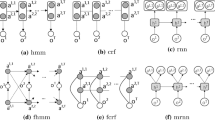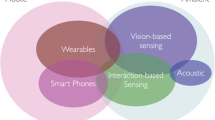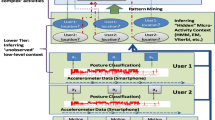Abstract
The pervasive sensing technologies found in smart homes offer unprecedented opportunities for providing health monitoring and assistance to individuals experiencing difficulties living independently at home. A primary challenge that needs to be tackled to meet this need is the ability to recognize and track functional activities that people perform in their own homes and everyday settings. In this paper, we look at approaches to perform real-time recognition of Activities of Daily Living. We enhance other related research efforts to develop approaches that are effective when activities are interrupted and interleaved. To evaluate the accuracy of our recognition algorithms we assess them using real data collected from participants performing activities in our on-campus smart apartment testbed.





Similar content being viewed by others
References
Cook DJ, Das SK (eds) (2004) Smart environments: technology, protocols, and applications, 1st edn, Wiley, New York
Cook DJ, Schmitter-Edgecombe M (2009) Assessing the quality of activities in a smart environment. Methods Inf Med (in press)
Doctor F, Hagras H, Callaghan V (2005) A fuzzy embedded agent-based approach for realizing ambient intelligence in intelligent inhabited environments. IEEE Trans Syst Man Cybern Part A 35(1):55–56
Liao L, Fox D, Kautz H (2005) Location-based activity recognition using relational Markov networks. In: Proceedings of the international joint conference on artificial intelligence, pp 773–778
Maurer U, Smailagic A, Siewiorek D, Deisher M (2006) Activity recognition and monitoring using multiple sensors on different body positions. In: Proceedings of the international workshop on wearable and implantable body sensor networks, pp 113–116
Mihailidis A, Barbenl J, Fernie G (2004) The efficacy of an intelligent cognitive orthosis to facilitate handwashing by persons with moderate-to-severe dementia. Neuropsychol Rehabil 14(1/2):135–171
Philipose M, Fishkin K, Perkowitz M, Patterson D, Fox D, Kautz H, Hahnel D (2004) Inferring activities from interactions with objects. IEEE Pervasive Comput 3(4):50–57
Reisberg B, Finkel S, Overall J, Schmidt-Gollas N, Kanowski S, Lehfeld H et al (2001) The Alzheimer’s disease activities of daily living international scale (ASL-IS). Int Psychogeriatr 13:163–181
Rialle V, Ollivet C, Guigui C, Herve C (2008) What do family caregivers of Alzheimer’s disease patients desire in smart home technologies? Methods Inf Med 47:63–69
Sanchez D, Tentori M, Favela J (2008) Activity recognition for the smart hospital. IEEE Intell Syst 23(2):50–57
Schmitter-Edgecombe M, Woo E, Greeley D (2008) Memory deficits, everyday functioning, and mild cognitive impairment. In: Proceedings of the annual rehabilitation psychology conference
Singla G, Cook D, Schmitter-Edgecombe M (2009) Tracking activities in complex settings using smart environment technologies. Int J BioSci Psychiatr Technol 1(1):25–35
Viterbi A (1967) Error bounds for convolutional codes and an asymptotically-optimum decoding algorithm. IEEE Trans Inf Theory 13(2):260–269
Wadley V, Okonkwo O, Crowe M, Ross-Meadows LA (2007) Mild Cognitive Impairment and everyday function: Evidence of reduced speed in performing instrumental activities of daily living. Am J Geriatr Psychiatry 16(5):416–424
Wren C, Munguia-Tapia E (2006) Toward scalable activity recognition for sensor networks. In: Proceedings of the workshop on location and context-awareness, pp 168–185
Author information
Authors and Affiliations
Corresponding author
Rights and permissions
About this article
Cite this article
Singla, G., Cook, D.J. & Schmitter-Edgecombe, M. Recognizing independent and joint activities among multiple residents in smart environments. J Ambient Intell Human Comput 1, 57–63 (2010). https://doi.org/10.1007/s12652-009-0007-1
Received:
Accepted:
Published:
Issue Date:
DOI: https://doi.org/10.1007/s12652-009-0007-1




